
Close to Zero - Grade 8
- Subject:
- Mathematics
- Material Type:
- Assessment
- Date Added:
- 07/18/2022

Close to Zero - Grade 8

Gate - Grade 8
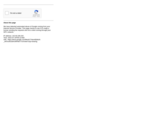
One, No, or Many - Grade 8
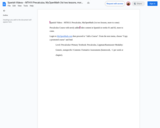
Precalculus Course with newly added video content in Spanish in weeks 01 and 02, more to come.
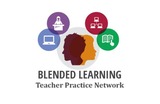
In this problem-based learning module, students will work collaboratively to improve the accessibility or safety of their school or community. For example, students could identify that accessibility ramps need to be added to the school property or additional sidewalks need to be created/repaired to increase the safety of students as they walk to school. Students would work together to create models of these improvements and create a communications plan that informs the stakeholders of the materials needed to create these improvements (i.e. using volume to determine the amount of concrete, using angles to determine measurements for ramps, etc..).

In this task, students complete a variety of tasks that include multiplying and subtracting fractions in order to ultimately find the area of a quilt.

Introductory Statistics is a non-calculus based, descriptive statistics course with applications. Topics include methods of collecting, organizing, and interpreting data; measures of central tendency, position, and variability for grouped and ungrouped data; frequency distributions and their graphical representations; introduction to probability theory, standard normal distribution, and areas under the curve. Course materials created by Fahmil Shah, content added to OER Commons by Victoria Vidal.

Materiały dodatkowe do nauczania matematyki, ktore pomogą w nauczaniu tego przedmiotu w sposób bardziej atrakcyjny.

Daily math assignments. Please refer to attached documents in this resource or your 'To Print' folder for required supplement material.

Daily math assignments. Please refer to attached documents in this resource or your 'To Print' folder for required supplement material.
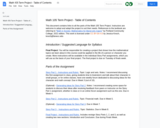
This document contains links to all the parts of the Math 105 Term Project. Instructors are welcome to adopt and adapt the project to suit their needs. References to the textbook are referring to “Math in Society: Mathematics for liberal arts majors” by Portland Community College, 2021 edition.
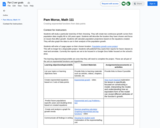
Students will study a particular town/city of their choosing. They will create two continuous growth curves from population data roughly 80 to 100 years apart. Students will describe the location they have chosen and focus on issues that affect growth. Students will calculate population projections based on the equations created. They will also graph the data to use in their analysis of the population growth.
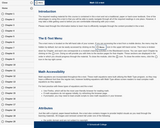
This interactive textbook includes practice problems, examples, and chapters that range from calculating angles and probability to annuities and applying geometry. The content in this e-text was developed using a variety of open educational resources, that were remixed to fit a math applications course in higher education.
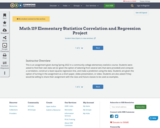
This is an assignment given during Spring 2022 in a community college elementary statistics course. Students were asked to find their own data set (or given the option of selecting from several sets that were provided) and compute a correlation, construct a least squares regression line, and make a prediction using the data. Students are given the option of turning in the assignment as a short paper, slides presentation, or video. Students are also asked if they would be willing to share their assignment with the class and future classes to be used as examples.
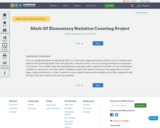
This is an assignment given during Spring 2022 in a community college elementary statistics course. Students were asked to find something within their own daily lives, relevant to them, and use counting techniques to enumerate that process. This includes things like washing dishes, selecting outfits, compute the number of meal combinations available at restaurants, and other actions. Students are given the option of turning in the assignment as a short paper, slides presentation, or video. Students are also asked if they would be willing to share their assignment with the class and future classes to be used as examples.
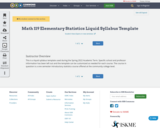
This is a liquid syllabus template used during the Spring 2022 Academic Term. Specific school and professor information has been left out and the template can be customized as needed for each course. The course in question is a one semester introductory statistics course offered at the community college level.
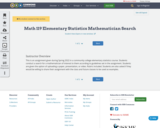
This is an assignment given during Spring 2022 in a community college elementary statistics course. Students conduct a search for a mathematician of interest to them according to guidelines set in the assignment. Students are given the option of uploading a paper, presentation, or video. Rubric included. Students are also asked if they would be willing to share their assignment with the class and future classes to be used as examples.
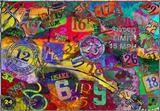
This course is an introduction to problem solving; logic, sets, and operations on sets; and properties and operations on whole numbers, integers, rational numbers, irrational numbers, and real numbers. Modelling techniques necessary for future elementary educators will also be covered in this course.
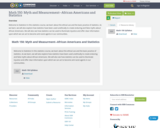
Welcome to Statistics! In this statistics course, we learn about the ethical use and the basic practice of statistics. As we learn, we will also explore how statistics have been used unethically to create enduring and false myths about African Americans. We will also see how statistics can be used to illuminate injustice and offer clear information upon which we can act to become anti-racist agents in our communities.
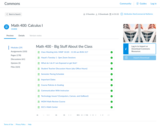
This is a rigorous, open, and equitable Calculus I class. It follows the OpenStax Calculus I book and uses the MyOpenMath course created by Larry Green and the ZTC grant as homework and extra resources. As well as lecture notes and worksheets created in Microsoft Word.
The structure of the course is that it follows a flipped class model, where students are required to watch lecture video created off of the lecture notes. Then students work on sectional exercises embedded in Canvas from MyOpenMath and work by themselves on the hard worksheet before the last day of the class during the week. On that day of class students will have the opportunity to work in groups on the worksheet problems.
They will be motivated to work on the problems in their groups because they will then teach the professor their random problem received as well as their group mates have points associated with their group mates work. The way they do this is through a program called GoReact that is embedded in Canvas. The main thing about this program is that students can easily share a recorded video of them teaching the math to the professor and the professor in turn can give video feedback telling the student how much they rock or letting them know what went wrong. These Teach Me Video are the foundation of the course and are the only thing the professor grades for the week unless there is a test. They are fun for both the instructor and students and increase the teacher student relationship as well as the student to student relationship. It is also easy to bump the Teach Me Videos up to make students who didn't fully understand the problem by making them redo the video to get some points back.